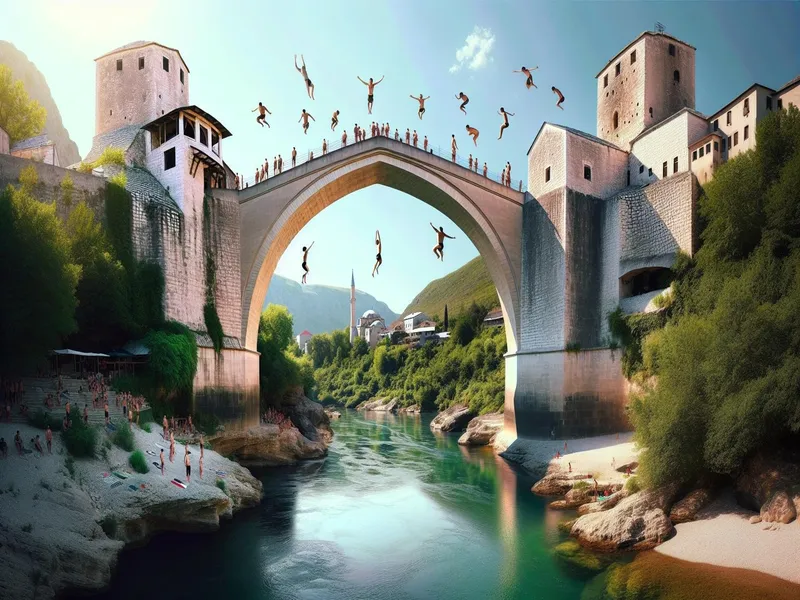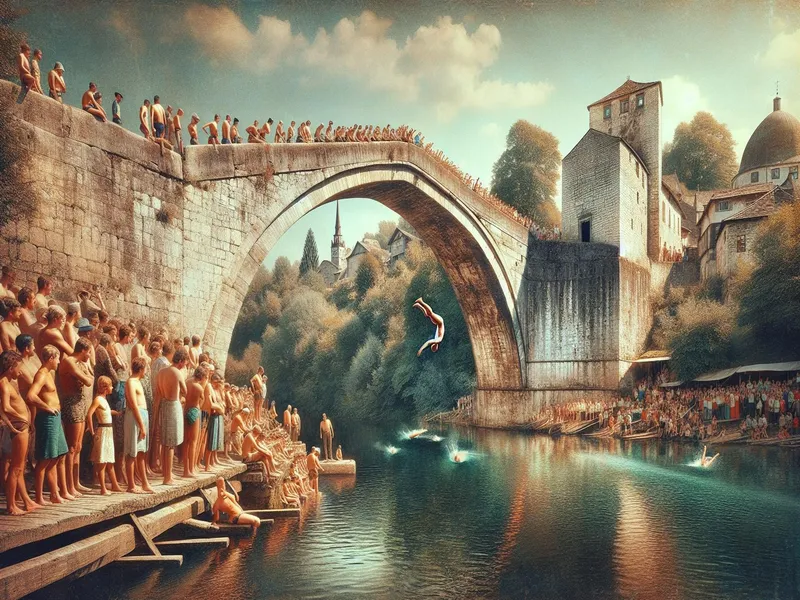the Mostar Bridge, a symbol of resilience in Bosnia. Explore its 16th-century architecture, cultural significance, and enjoy local traditions on your backpacking journey.

Historical Background
Alright, let’s jump into the history behind the Mostar Bridge. Picture it: it’s the 16th century, and the Ottomans are ruling over Bosnia and Herzegovina. They decide to build a bridge that connects two parts of Mostar over the Neretva River. The result? An architectural marvel that stands tall for centuries.
The bridge wasn’t just any old structure. It was designed by Mimar Hayruddin, a student of the famous Ottoman architect Mimar Sinan. Imagine being tasked with creating something so magnificent without modern tools! Yet, he did it, and for 427 years, this stone beauty stood as a testament to human ingenuity.
Fast forward to the 1990s during the Bosnian War. Sadly, in 1993, amidst conflict and chaos, this iconic bridge was destroyed. I remember reading about how devastating it was for locals — losing such an essential part of their cultural identity .
But here’s where things get inspiring . After the war ended, efforts began almost immediately to rebuild this symbol of unity and resilience. By 2004, Mostar Bridge had been reconstructed using original techniques and materials as much as possible. It’s like they breathed new life into an old friend.
Now when you visit (and trust me, you should), you’ll see people diving off this bridge during summer festivals – a tradition dating back centuries! These divers aren’t just thrill-seekers; they’re partaking in a ritual that celebrates bravery and heritage ♂️.
Architectural Significance

The Mostar Bridge isn’t just a pretty sight; it’s an architectural gem with deep roots in history. Let’s jump into what makes it so special.
Design and Construction
When you first lay eyes on the Mostar Bridge, its elegant arch stands out immediately. Built in the 16th century, it was designed by Mimar Hayruddin, who was a student of the famous architect Mimar Sinan. Imagine being tasked to create something that would last centuries—no pressure!
The bridge is constructed from tenelija, a local limestone that’s not only strong but also has this unique glow under sunlight. The original construction techniques were painstakingly replicated during its reconstruction after the Bosnian War. Workers used traditional tools and methods to ensure authenticity.
Fun fact: The bridge’s arch spans about 96 feet (29 meters) and rises nearly 66 feet (20 meters) above the Neretva River. That’s like jumping off a seven-story building! Divers leap off this height every summer during festivals—a must-see if you’re visiting.
Engineering Marvels
Let’s talk about engineering for a sec because this bridge is no ordinary structure. It’s an example of Ottoman ingenuity at its finest. Picture this: back in 1566, they didn’t have modern machinery or computer-aided design software—just skill and determination.
The bridge’s single-span design was revolutionary for its time. It connects two parts of Mostar seamlessly, symbolizing unity between different cultures and communities—a harmony we could use more of today.
For all you backpackers planning to visit, here are some cool things to note:
- Symmetry: The bridge is perfectly symmetrical, which is aesthetically pleasing.
- Durability: Even though wars and natural elements, it stood strong for over four centuries.
- Reconstruction: After being destroyed in 1993, UNESCO declared it a World Heritage Site post-reconstruction—a nod to its historical importance.
Cultural and Symbolic Importance

Mostar Bridge isn’t just a pretty sight; it’s got some serious cultural heft. This bridge has stories, legends, and a whole lot of heart woven into its stones.
Local Legends and Traditions
You know that feeling when you stumble upon a local legend while backpacking? Mostar Bridge is full of them. One popular story talks about Mimar Hayruddin himself. They say he was so confident in his design that he stood beneath the bridge during its first test, ready to face the consequences if it failed. Spoiler alert: it didn’t!
And then there’s the diving tradition. Picture this: every summer, locals gather for Stari Most’s diving competition. Brave souls leap off the 78-foot-high bridge into the Neretva River below. It’s not just for thrills—these dives are a rite of passage and a way to honor their heritage.
If you’re planning your trip around this event, here’s a quick checklist:
- Date: Usually in July
- Location: Stari Most, Mostar
- What to Bring: Camera , sunscreen , maybe even swim trunks if you’re feeling bold!
Impact on Bosnian Identity
The bridge isn’t just an architectural marvel; it’s like Bosnia and Herzegovina’s heartbeat. Imagine being from a place where one structure holds centuries of your people’s spirit and resilience.
During the war in 1993, when the bridge fell, it wasn’t just stone hitting water—it was like losing an old friend who’d always been there. But guess what? The people rebuilt it stone by stone using original materials and techniques! Talk about dedication.
I’ve met locals who tear up talking about its reconstruction because it symbolizes more than connection between two riverbanks—it represents unity after strife. Visiting Mostar Bridge gives you this profound sense of standing at history’s crossroads where past meets present seamlessly.
So next time we wander through Europe with our backpacks packed tight (don’t forget those extra socks!), let’s remember places like Stari Most aren’t just stops on our itinerary—they’re stories waiting to be told.
Tourism and Economic Impact
Mostar Bridge isn’t just a sight to behold; it’s a lifeline for the city. This iconic structure pulls in tourists from all over, creating ripples of economic benefits.
Visitor Experience
Standing on Mostar Bridge feels like stepping back in time. Imagine gazing at that elegant arch and feeling the smooth tenelija limestone beneath your feet. It’s magical! You can see why so many flock here, cameras ready.
Must-do activities:
- Bridge Diving: Locals dive off the bridge during summer festivals—a thrilling spectacle!
- Stroll Through Old Bazaar: Nearby, you’ll find cobbled streets lined with shops selling handcrafted souvenirs.
- Visit Museums: The Museum of War and Genocide Victims offers deep insights into Bosnia’s turbulent history.
Got your backpack? Pack light—comfy shoes for those cobblestones and a good camera are essentials! ✨
Contributions to Local Economy
Tourism around Mostar Bridge boosts the local economy significantly. Every visitor means more business for cafes, restaurants, and souvenir shops.
Here’s how it breaks down:
| Aspect | Impact |
|---|---|
| Accommodation | Hotels and hostels see higher occupancy rates |
| Dining | Restaurants thrive with diverse clientele |
| Retail | Souvenir shops benefit from tourist purchases |
Local artisans sell crafts inspired by the bridge’s design—think beautiful jewelry or intricate carvings. It’s heartwarming to know that every dollar spent helps community members support their families.
Restoration and Preservation Efforts
Hey there! If you’re as fascinated by the Mostar Bridge as I am, you’ll love learning about how this iconic structure was brought back to life and what’s being done to keep it standing strong. Let’s immerse!
War Damage and Reconstruction
The Mostar Bridge faced severe damage during the Bosnian War in 1993. It felt like a punch to the gut for the locals because this wasn’t just any bridge—it was a symbol of unity and resilience. Seeing it destroyed left everyone heartbroken.
But here’s where things get inspiring. As soon as peace returned, efforts to rebuild began almost immediately. With international support, including UNESCO’s recognition of its historical importance, reconstruction kicked off in earnest. Using original techniques and tenelija limestone—the same material used centuries ago—engineers meticulously pieced it back together.
By 2004, the bridge stood tall once more, looking almost identical to its former glory days. Walking across it now feels like stepping into history, knowing that each stone tells a story of perseverance.
Ongoing Preservation Challenges
Even though the Mostar Bridge looks fantastic today, keeping it in top shape isn’t exactly a walk in the park. This ancient marvel faces several ongoing challenges that require constant attention.
First off, natural elements like water erosion pose significant threats. The Neretva River flows beneath with considerable force during heavy rains or snowmelt periods, which can gradually wear down even sturdy structures like this one.
Then there’s human impact—tourists (like us!) flock here year-round to witness its beauty up close but all those footsteps add up over time! Local authorities have had to carry out measures such as controlled access points especially during peak seasons ensuring both safety & preservation simultaneously.
The local government collaborates closely with international experts conducting regular assessments maintaining structural integrity while respecting historical authenticity—a delicate balancing act indeed!
Visiting the Mostar Bridge isn’t just about admiring an architectural masterpiece; it’s about connecting with a powerful symbol of resilience and unity. The bridge stands as a testament to human ingenuity and the enduring spirit of the Bosnian people.
As I stood on this historic landmark, I felt a profound sense of history and hope. It’s more than just stone and mortar; it’s a living monument that continues to inspire generations.
Whether you’re drawn by its beauty, its historical significance, or its cultural impact, the Mostar Bridge offers an experience unlike any other. This iconic structure is not only a must-see for travelers but also a beacon of strength that transcends time.